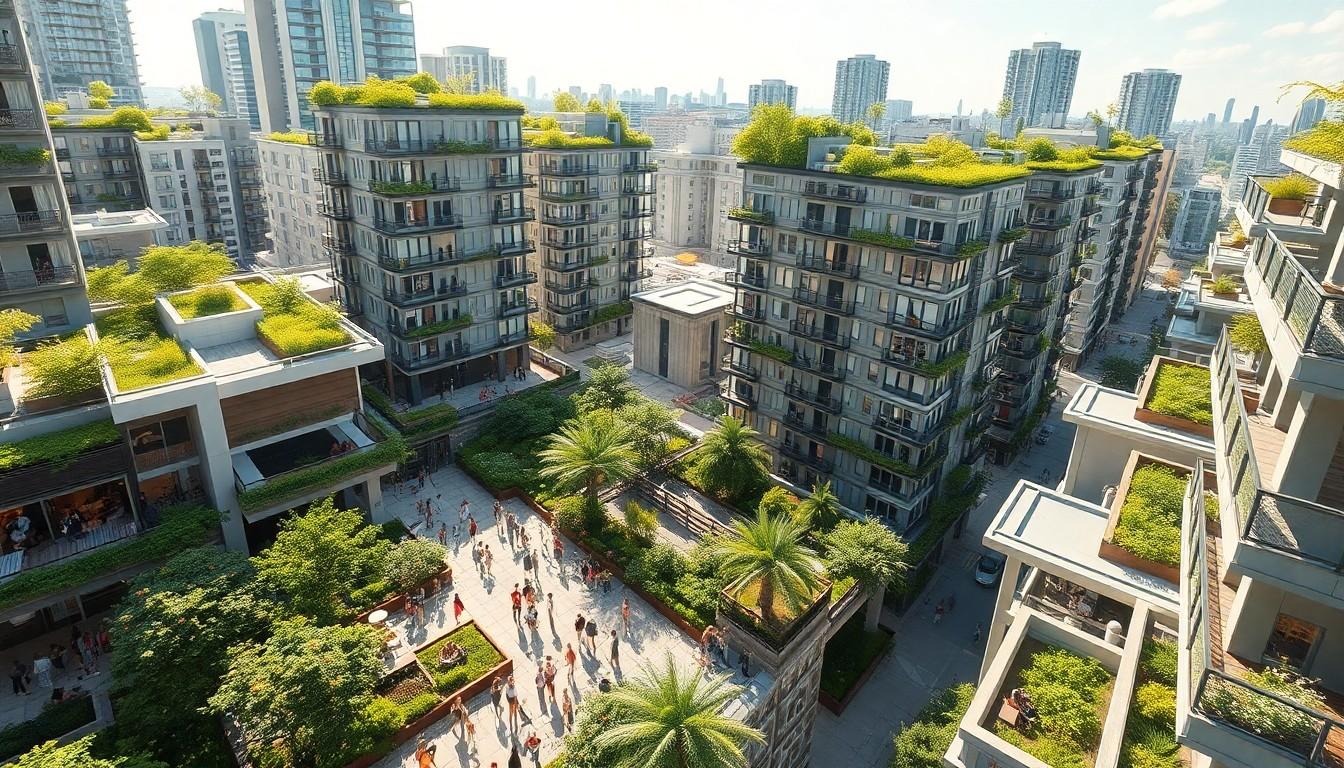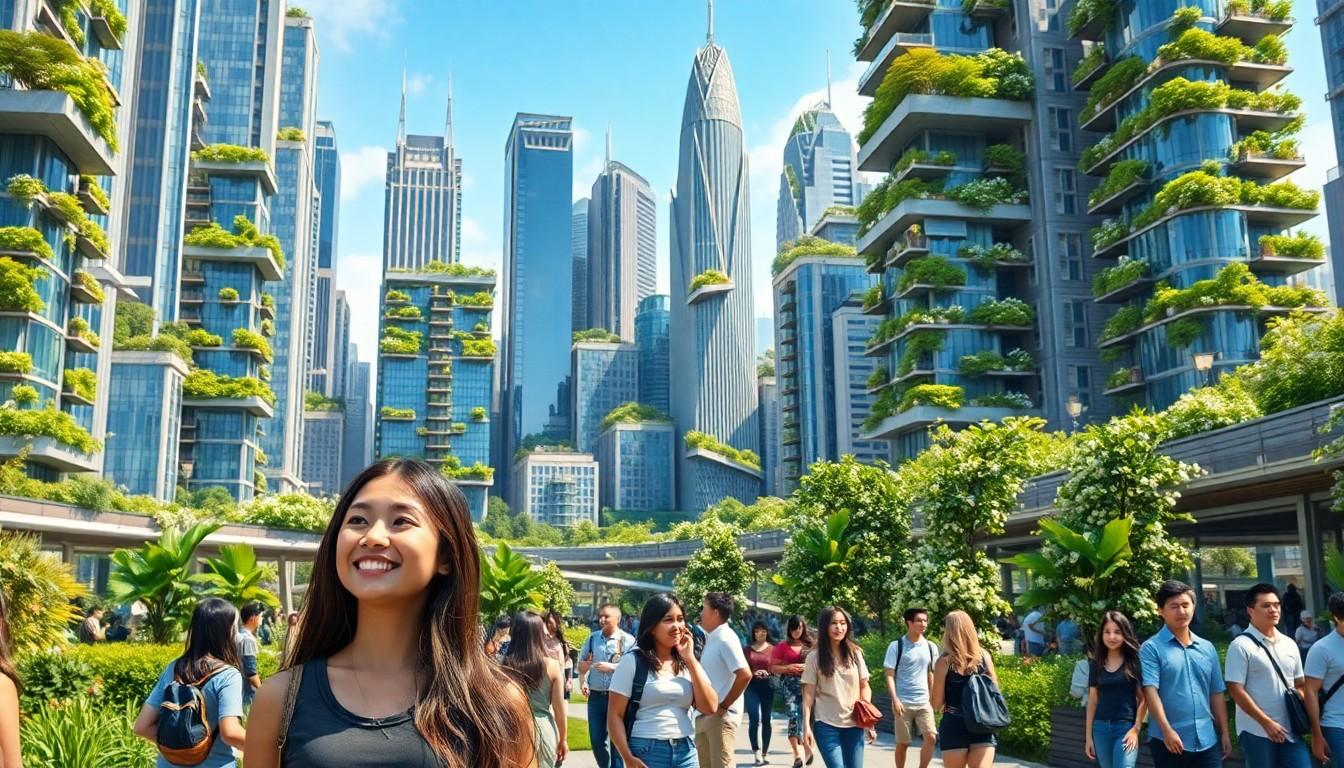Imagine living in a city where you never have to fight traffic or search for parking. Welcome to the vertical city—a futuristic concept that’s turning heads and sparking conversations about sustainable living. With skyscrapers that reach for the sky and eco-friendly designs, these urban marvels promise to revolutionize how we think about city life.
Vertical City A Solution for Sustainable Living PDF
Vertical cities represent a significant shift in urban development strategies. Architects and urban planners envision these cities as multi-layered structures that house residential, commercial, and recreational spaces within a single building. Skyscrapers, with their extensive vertical space, facilitate efficient land use, especially in densely populated urban areas.
Design elements in vertical cities focus on sustainability. Green roofs and walls contribute to improved air quality while providing space for urban agriculture. Energy-efficient systems harness natural resources, reducing reliance on non-renewable energy sources.
Water recycling systems feature prominently in these designs, significantly decreasing water consumption. Rainwater harvesting and greywater recycling allow buildings to recycle up to 40% of their water use.
Community spaces within vertical cities promote social interaction and cohesion. These developments include parks, coworking areas, and retail options that encourage residents to engage with their surroundings. Public transport accessibility remains a priority, enhancing mobility and reducing vehicle dependency.
Research indicates that vertical cities can reduce urban sprawl and protect natural landscapes. Over 80% of global populations live in urban areas; addressing housing shortages sustainably becomes essential. Innovative infrastructure supports a harmonious balance between nature and urban living, contributing to a healthier lifestyle.
Examples of existing vertical city concepts include the Vertical Forest in Milan and the Bosco Verticale, which each integrate greenery into their design. As this approach gains traction, it presents opportunities for countries worldwide to adopt sustainable living practices in urban planning.
Benefits of Vertical Cities

Vertical cities offer numerous advantages that contribute to sustainable living. These benefits encompass environmental, economic, and social aspects.
Environmental Impact
Vertical cities promote significant environmental benefits. They often feature green roofs, which can lower urban temperatures. Buildings designed to incorporate plants improve air quality and support biodiversity. Water recycling systems reduce consumption, achieving reductions of up to 40%. Less land is required for development, preserving natural habitats and reducing the urban footprint. With efficient energy systems, vertical cities decrease carbon emissions and utilize renewable sources effectively. Shifting focus from horizontal expansion to vertical growth helps mitigate urban sprawl, protecting vital ecosystems.
Economic Advantages
Economic benefits arise from concentrated development in vertical cities. High-density living decreases transportation costs and encourages the use of public transit. Residents share amenities, thereby lowering individual expenses. Local businesses thrive in integrated commercial spaces, increasing foot traffic without necessitating increased operational costs. Construction and maintenance of vertical cities create numerous job opportunities, boosting local economies. These cities enhance property values, driven by convenient access to resources and services. Reduced reliance on vehicles also cuts down expenses related to fuel and maintenance.
Social Benefits
Social advantages contribute to the overall appeal of vertical cities. Community spaces within these structures foster interaction and engagement among residents. Increased accessibility to parks and recreational areas promotes healthier lifestyles. Vertical cities support inclusive living by integrating various housing types, ensuring diverse populations coexist. Increased public transport options enhance mobility, providing residents with a range of commuting choices. People in vertical urban settings often develop a stronger sense of community belonging. Access to cultural amenities also enriches daily life, encouraging a vibrant social atmosphere.
Design Principles of Vertical Cities
Vertical cities incorporate innovative design principles that emphasize sustainability and efficiency. Focused on energy management and ecological balance, these principles enable harmonious urban living.
Sustainable Architecture
Sustainable architecture in vertical cities promotes eco-friendly building practices and material use. Green roofs, for example, not only provide insulation but also support biodiversity. These structures often integrate renewable energy sources such as solar panels, which can reduce energy costs by up to 30%. Rainwater harvesting systems contribute to water conservation, addressing the global water crisis effectively. Recycled materials are frequently used in construction, which minimizes waste and environmental impact.
Urban Planning Strategies
Urban planning strategies within vertical cities prioritize mixed-use developments. Blending residential, commercial, and recreational areas fosters community cohesion and reduces the need for extensive commuting. Proximity to public transit hubs enhances accessibility, encouraging people to rely on sustainable transportation options. Zoning regulations support vertical expansion, making efficient use of limited land resources. Additionally, integrating green spaces into these designs improves air quality and overall well-being for residents.
Challenges in Implementing Vertical Cities
Vertical cities face several challenges that hinder their full realization. Here are the main obstacles:
Technological Barriers
Implementing vertical cities depends heavily on advanced technology. Innovative building materials, such as lightweight composites, must undergo further research for widespread use. Construction techniques require adaptation to suit high-rise developments. Additionally, smart systems for energy management and waste recycling need integration into design protocols. Compatibility with existing infrastructure poses another significant issue. As cities gradually transition, significant investment in technology and training becomes necessary.
Social Acceptance
Social acceptance plays a crucial role in the success of vertical cities. Communities may resist the idea due to traditional views on urban living. Concerns regarding changes in the urban landscape often arise. Addressing fears about building safety and environmental impact is essential to gaining public support. Public engagement initiatives that highlight the benefits of vertical living can foster a sense of ownership. Collaborating with local populations during the planning process enhances trust and addresses community concerns effectively.
Case Studies of Successful Vertical Cities
Milan’s Vertical Forest showcases innovative urban design. The project features two residential towers covered with over 9,000 trees, which improve air quality and provide natural insulation. Residents enjoy reduced energy costs, with energy savings reported at approximately 30%.
Singapore’s Parkroyal on Pickering emphasizes green architecture. This hotel incorporates lush gardens, sky terraces, and a rainwater harvesting system. Visitors experience a blend of nature and luxury, enhancing their stay while promoting eco-friendliness.
Dubai’s Marina 101 exemplifies vertical living on a grand scale. Standing at 425 meters, it ranks as one of the tallest residential buildings globally. With mixed-use facilities, the structure enhances community interaction while offering stunning views.
Vancouver’s Shangri-La Hotel integrates urban living with nature. This skyscraper includes green roofs and energy-efficient systems. Its design encourages sustainable practices and provides a relaxing environment for both guests and residents.
The Bosco Verticale project in Milan had a significant impact on the surrounding urban area. By providing housing with integrated greenery, it created a balanced ecosystem that mitigates pollution and fosters biodiversity. More than 20,000 plants contribute to a healthier microclimate.
In Tokyo, the Morisawa Building serves as a model for vertical urbanity. This structure focuses on vertical gardens and sustainable construction materials. It demonstrates the effectiveness of incorporating greenery into high-rise architecture, enhancing both aesthetics and resident well-being.
These case studies illustrate the potential of vertical cities. Each project addresses urbanization challenges while emphasizing sustainability and community engagement. They highlight the practical benefits of implementing eco-friendly designs and creating harmonious living spaces in urban environments.
Redefine the Future of Urban Environments
Vertical cities present a transformative approach to urban living that addresses pressing challenges like congestion and environmental degradation. By integrating sustainable design with community-focused spaces, these cities offer a blueprint for healthier and more efficient living. The successful implementation of vertical cities can lead to enhanced air quality, reduced energy consumption, and stronger community ties.
As urban populations continue to grow, embracing vertical living could be key to creating resilient and sustainable cities. Engaging local communities in the planning process will be crucial to overcoming resistance and ensuring that these innovative solutions meet the needs of residents. With the right investment and commitment, vertical cities could redefine the future of urban environments.

